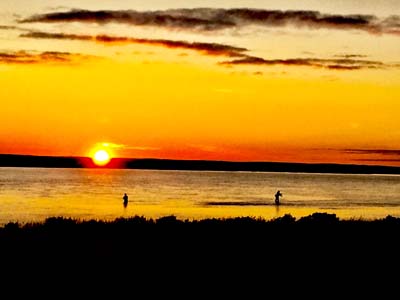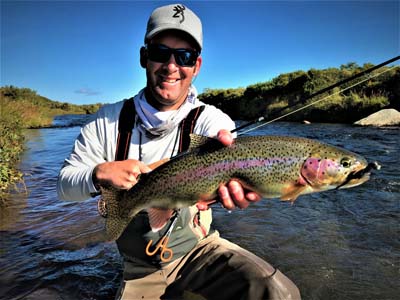By Kent Danjanovich
Alaskan water facts – Alaska has more than 40% of the entire nation’s surface water resources. About three-fourths of all fresh water in Alaska is stored as glacial ice that covers nearly 5% of the state. Alaska has more than 3,000,000 lakes, over 12,000 rivers, thousands of streams and creeks and an estimated 100,000 glaciers. Now that is pretty impressive!
Now here’s another tidbit of information that is interesting. Southwest Alaska (Bristol Bay) is home to the largest run of salmon in the state (over 61,000,000 in 2018), while also being home to the three largest lakes; Iliamna, Becharof and Naknek. It’s no wonder thousands of fishermen flock to this part of the state in search of salmon and all of the other creatures that depend on them.
Over the last few years, even with the salmon numbers in many areas reaching historic numbers (during our lifetime anyway), many river systems have started to struggle at times. But one river in the Bristol Bay region that has been literally on fire is the Egegik, with its headwaters beginning at the aforementioned Becharof Lake, about 300 miles southwest of Anchorage. All five Pacific salmon species make their way up the Egegik on their way to their spawning grounds yearly, to the waters of their birth to complete their life cycle.
Well, as luck would have it, I had the pleasure of meeting Dave Mandich, owner of Becharof Rapids Camp a few years ago at the Sacramento Intermountain Sports Expo. He took a few minutes from his busy schedule to fill me in on his location and operation at the show and then I took that information back to the office to do some more research about the area. Plans were quickly made for a visit that fall and the rest is history. 2018 marked my third visit to their camp, with each one even better than the last, which is pretty tough to do!
 Each time we visit one of our Platinum Approved Outfitters and Lodges, we do a follow-up story on our visit and also film the trip for use in promoting their operation. Now because of the exposure we are able to give our endorsed lodges and outfitters, we get hundreds of calls and emails each year, asking specific questions about what each have to offer. If fact, many potential guests even ask when we will be visiting the operation again, in hopes of scheduling their trip to coincide with ours. And that was just the case this time around, as a couple of good friends of mine, along with some good friends of theirs, would be joining me and fellow Pro-Staffer, Steve McGrath on this trip, giving us eight of the 12 spots at the camp for our six-day trip, the first week of September.
Each time we visit one of our Platinum Approved Outfitters and Lodges, we do a follow-up story on our visit and also film the trip for use in promoting their operation. Now because of the exposure we are able to give our endorsed lodges and outfitters, we get hundreds of calls and emails each year, asking specific questions about what each have to offer. If fact, many potential guests even ask when we will be visiting the operation again, in hopes of scheduling their trip to coincide with ours. And that was just the case this time around, as a couple of good friends of mine, along with some good friends of theirs, would be joining me and fellow Pro-Staffer, Steve McGrath on this trip, giving us eight of the 12 spots at the camp for our six-day trip, the first week of September.
Now, just to let you know, it was no small feat just securing the spots for this trip. Because of the success on the Egegik for sockeye and silver salmon over the past few years, the return clientele get the first crack at spots for the next season. We were fortunate enough to find a week that we could sneak into. We would also be able to work out the schedule to include an over-nighter at Gertrude Lake for a little rainbow, Arctic char and grayling action, as four of our group would fly directly to that camp, while the rest settled in at the main camp on the Egegik, targeting silvers.
Steve and I decided to split up in order for us to both be able to capture footage at both locations. Steve’s group would include most of the “younger” hikers, giving them the opportunity to get back into waters that hadn’t had much pressure and boy did they take advantage of the situation! Their group of four had two days of some of the best topwater action imaginable, both with mouse patterns and just about any dry fly offering. Rainbows and Arctic char to the mid 20’s and Arctic grayling to nearly 20-inches were the norm and in big numbers. And when we changed places with them the next night, our full day on the creek surrendered much the same, but on bead-head wooly buggers and caddis dries.
Meanwhile, back at the main camp on the Egegik – well, “hot and heavy” would definitely describe the fish – screaming hot silvers and yes, on the heavy side, with the average in the 12+ pound range. Let’s just say you know the fishing is exceptional when you have eight, hard-core fishermen that are willing to go in for lunch back at the camp, just to take a break from the non-stop action. And, when we got back to camp and the lunch line, Nancy had outdone herself with a seafood spread that was fit for a king! Beer-battered cod, crab legs, deep-fried calamari, salads, desserts – oh my!
 After we had gorged ourselves and traded a few tall stories with the other guests, we all headed back out to another hot spot on the river, this time a short distance below camp in an area where the river opens up into an expansive ‘flats’ area. As we approached, fins and tails could be seen surfacing everywhere, as the wind was minimal and the water appearing like glass. Although most of us were throwing pink, purple, black or chartreuse bunny leeches and Dolly Llamas, others found the fishing just as hot with spin cast outfits, retrieving Mepps spinners and pixies.
After we had gorged ourselves and traded a few tall stories with the other guests, we all headed back out to another hot spot on the river, this time a short distance below camp in an area where the river opens up into an expansive ‘flats’ area. As we approached, fins and tails could be seen surfacing everywhere, as the wind was minimal and the water appearing like glass. Although most of us were throwing pink, purple, black or chartreuse bunny leeches and Dolly Llamas, others found the fishing just as hot with spin cast outfits, retrieving Mepps spinners and pixies.
We eventually made our way back to camp at about 5:30pm. As we talked it over with each other, our total number of fish landed that afternoon was well into the triple digits, resulting in a stringer full of 40, chrome bright silvers, just a few hours out of the bay. In all, our group would harvest over 540-pounds of fillets that were processed, frozen and boxed by the staff for our trip back to the lower 48 at the end of the week.
Becharof Rapid Camp came through for the Sportsman’s News Team once again and you can bet it won’t be our last visit. Plans are already being made for a return trip during the 2020 season. Dave Mandich and his staff do a great job in all facets of their Alaska operation. Their accommodations are great for a remote camp, the food is outstanding and the fishing, well if you can’t tell from this article just how we feel about that – I guess you need to just get on the phone and book your own trip to southwest Alaska and Becharof Rapids Camp (360-532-7594). Their standard trip is six-days and five-nights, with everything taken care of once you get to King Salmon. Fly-outs can be incorporated as part of your trip or as an add-on (and they are highly recommended) for an additional fee. And don’t forget to tell them that Sportsman’s News sent ya!

